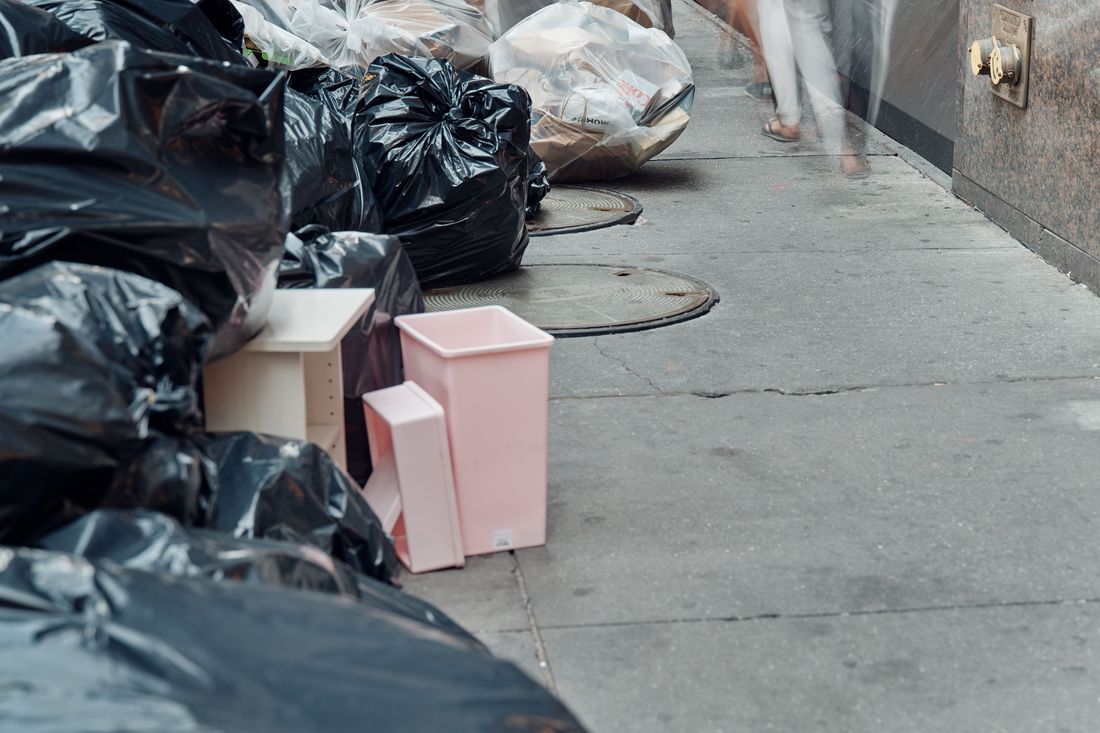
It was the evening before trash day when I learned that rats get the zoomies, a phenomenon I previously only associated with dogs who suddenly run around in circles to express joy. The three or four rats I saw ahead of me on St. John’s Place had a lot to be happy about as they did laps on a tiny patch of grass; along the block, a tantalizing smorgasbord of trash bags awaited them. When I heard them erupt into tiny squeaks, I yelped and jumped into the street. There was no way I was going to stay on the sidewalk during rat dinnertime.
It doesn’t have to be this way: the trash-bag mountains clogging our sidewalks for hours, the garbage juice pooling on the curb, the stench hanging in the air, and, above all, the rats brazenly mining the piles for food. Why can’t New York City put its trash in bins until it’s picked up? Only 10 percent of the city’s trash is in containers. But changing the way 8.8 million people have become accustomed to doing something would require a cultural shift in the city’s approach to collecting refuse. Sure, we have recycling (and some composting) now, but the logistics of collection haven’t changed much in 60 years; we just keep piling bag after bag on the sidewalk. The political drive and the resources needed to overhaul the current system — from the way people throw out trash to how trucks are designed to how often workers collect it — are immense.
In some ways, the problem was built right in. When city commissioners plotted New York’s street grid in 1811, they didn’t include service alleys, in order to maximize real-estate development. Trash had only one place to go: right on the street. New Yorkers have been knee-deep in waste ever since. And then there is the problem of scale: Even though the average New Yorker creates less refuse than the average American, the city is the most populous in the country, and it simply generates too much trash, to the tune of 14 million tons every year. What container can possibly hold the mountains of bags found outside a 30-story high-rise? And where is the curb space to store them? (To suggest converting a single parking space to something else is a recipe for instant outrage among drivers.) The city’s bifurcated collection system also makes it hard to imagine a single solution: The Department of Sanitation collects residential and institutional refuse, while a slew of private carting companies handles the rest.
Hot Garbage Month
It may seem as if it’s been this way forever, but the city’s trash wasn’t always stored in flimsy plastic sacks. That practice began in the 1960s, when DSNY workers went on strike for better wages and trash accumulated on the streets. In response, the plastics industry donated bags, a new product, as a stopgap. The Department of Sanitation — which was dealing with a fiscal crisis that rendered 30 percent of its vehicles inoperable — welcomed the change. It called bagged garbage “highly collectible” and claimed that productivity improved by 20 percent in areas that shifted to plastic bags. Residents and building managers appreciated how they were “cleaner and quieter” than metal trash cans. But to a rat, there’s not much difference between garbage thrown out of a window and garbage that’s bundled in plastic. “This is a rat-nutrition program, as far as I’m concerned,” says Steven A. Cohen, the former executive director of the Earth Institute’s Research Program on Sustainability Policy and Management at Columbia University and the author of The Sustainable City. “The rats are getting bolder, and frankly, that’s what I think will be the motivator.”
Some might argue that New York City is simply too big or too complex to manage the scale of its waste problem. But it is dead last compared with other major cities. Barcelona’s sidewalks stay clean because the city places communal receptacles on the street for people to dispose of household trash and recycling. Amsterdam goes one step further, placing communal receptacles for residential trash underground. About 20 percent of homes in Stockholm dispose of trash through pneumatic tubes that use air pressure to whisk waste away — a technology Roosevelt Island and Hudson Yards also use. Perhaps the furthest leap from our current system is in Taipei, where a population of roughly 4 million people throws waste directly into a truck so it never festers on the sidewalk. Rather than being a distasteful chore, trash pickup is when neighbors can socialize and check in on each other. Imagine that.
Closer to home, San Francisco — the second-densest large city in the U.S., after New York — has a system that successfully relies on containerized pickup. It’s centralized; Recology, a publicly regulated private company, has been the sole collector and processor of San Francisco’s residential and commercial waste since the 1930s. Commercial waste is kept off the streets, stored in covered dumpsters in trash rooms and loading docks until it’s carted away. For residential trash, Recology’s standardized three-bin system for trash, recycling, and compost has been in place since 2001. The company also offers an “inside” service (for an extra charge) to collect waste from trash rooms and storage areas so some customers never have to drag their trash to the curb. As a private company, Recology has a business incentive to make collection as efficient as possible. It uses two types of trucks: Split-body trucks collect waste and compost, while single-load trucks handle recycling. Because the trucks have mechanical arms that grab even the residential carts, only one worker is needed per truck, which speeds up the process and makes it less expensive. “Sixty percent or more of the cost of refuse is labor, drivers picking that material up curbside,” says Alexa Kielty, a Zero Waste program coordinator in San Francisco’s Department of the Environment. The city says 99 percent of customers comply with this system, and while street litter is a challenge, residential and commercial waste accumulating on the curb isn’t.
There are hints that New York City wants to catch up, beginning with its leadership. “The politician that solves the trash problem is not gonna be anybody’s hero, and that’s been the steady problem,” says Cohen. “It’s not considered a high enough priority in a city facing multiple crises — it’s competing with homelessness, education, policing — so there’s been very little creativity and innovation in waste management,” he says. But Mayor Eric Adams has enthusiastically endorsed ratproof trash receptacles for street litter and seems to have a personal vendetta against vermin. New sanitation commissioner Jessica Tisch and several city councilmembers also seem extremely eager to change how we handle trash, including Councilmember Sandy Nurse, who co-sponsored legislation to bring curbside compost to every household in the city. There have been some missteps: With its new Clean Curbs pilot, the city is finally piloting containerization for commercial waste in Times Square, but it’s in the form of small, leaky receptacles. It’s easy to see how a product that was originally designed to hold residential trash cans would struggle with the scale of trash at a major tourist destination in one of the busiest areas of the city.
But beyond small-scale pilots and rat-bucket press conferences, it appears the city wants to explore bin pickup for everyone: New York is embarking on its first study to explore citywide trash containerization. The Economic Development Corporation recently issued a request for proposal for consultants who can conduct a feasibility-and-cost study to develop “a uniform, scalable program that’s adaptable to the needs of all of New York City’s diverse communities.” The RFP involves some pretty big asks, proposing that vendors examine environmental variables such as land use, density, and geography; talk to other cities that have successfully done this; determine the best types of containers and how they fit within different streetscapes; and analyze how the containers might affect quality-of-life concerns such as appearance, impact on pedestrians, and effectiveness at holding back the rats. Vincent Gragnani, a Department of Sanitation spokesperson, admits that a citywide approach would be pretty costly, especially one that would function year round and in areas where sidewalks and streets are so narrow that containers might block a snowplow or a wheelchair user. “We also have to keep in mind that containerization is not a silver bullet — we have seen plenty of images from European cities of trash piled around containers,” he says. He’s right. The success of such a program depends on how frequently containers are emptied, which will require more sanitation workers, more equipment, and more money to make it all happen. The study is slated to be done by July 2023. But the budget for executing any plan is “subject to the availability of funds,” the RFP notes.
Where would the money to launch citywide bin pickup come from? Currently, the system of paying for trash via tax revenue alone means its funding is provisional and limited, competing yearly with public health, housing, and schools for a slice of the municipal budget. And as we’ve seen during the pandemic, when the city is faced with budget deficits, sanitation is one of the first programs to get cut. This funding method also makes it easy for individuals to throw out unlimited trash without having to think of the costs involved. Structuring waste collection like a utility — in which the amount of waste you generate is tied to a proportional fee — might offer a solution. It’s how many cities on the West Coast as well as Austin and Portland, Maine, do it. San Francisco’s Department of the Environment credits the “pay as you throw” structure for diverting 55 percent of its refuse to recycling and compost instead of the landfill; New York is at only 20 percent. And the cost of this service is reasonable: The monthly bill for recycling, trash, and compost is about $35 for most households, based on a rate set by the city government, with discounts for low-income households. The city was savvy about how to kick this off; when it introduced composting, it was free, which incentivized more composting. “We were forcing businesses to save money,” Kielty says. Composting at a large scale made it less expensive for the city. Organics processing costs San Francisco about $80 a ton. In New York, compost costs more to process, about $132 per ton. With collection factored in, the cost of compost jumps to $734 per ton. If composting is expanded citywide, and the rate of compost was similar to that of recycling, the cost per ton to collect and process would be only $40 more than the cost of landfill, which is about $220 per ton, according to an Independent Budget Office estimate. (There are, of course, environmental benefits to reducing methane emissions from landfills and providing sustainable fertilizer, which can’t be easily quantified in dollars and cents.)
DSNY has studied the possibility of a “pay as you throw” system, but before New York City embarks on anything like it, the agency says it needs to reduce the amount of waste and have consistent compost collection citywide. “Equity is key,” Gragnani says. “We believe that it is important to first give New Yorkers every opportunity to do the right thing, and that includes making it easy to compost food waste.” One of the largest containerization experiments the city has embarked upon is happening in Queens. Come October, there will be automatic weekly curbside composting for every household in the borough. No one needs to opt in (building managers often oppose composting services), and DSNY is providing sealed, ratproof bins to all addresses with ten or more units. “Many building maintenance workers and their residents think a bin full of organic material smells bad or attracts rats,” Gragnani says. “To them we would say, ‘Your trash smells now and attracts rats now. Putting all organic material in a single secure container will reduce both of these problems.’” To launch the pilot, the agency redesigned collection routes, hired 76 more workers, and reallocated dual-bin trucks from other parts of the city to collect the compost in Queens. The total cost of the program, including the processing of organic material, is $2 million. The program will pause in December because of “little yard waste being collected” before returning in March 2023. This is discouraging; changing behavior in the long run requires reinforcement and consistency. At least it’s a step in the right direction.
Will the momentum of these small steps be enough to bring us to the finish line? If other major cities have found a way to corral their waste, New York City can, too. Our acceptance of rat dinnertime has gone on long enough.






